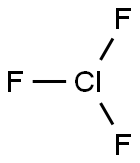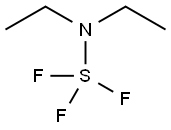Antimony trifluoride
Synonym(s):Antimony trifluoride;Antimony(III) fluoride;Trifluorostibine
- CAS NO.:7783-56-4
- Empirical Formula: F3Sb
- Molecular Weight: 178.76
- MDL number: MFCD00011218
- EINECS: 232-009-2
- SAFETY DATA SHEET (SDS)
- Update Date: 2025-09-25 17:15:13

What is Antimony trifluoride?
Description
Antimony trifluoride is a noncombustible,odorless, white to gray crystalline solid. Molecularweight= 178.75; Specific gravity= 4.38 at 21℃ (solid);Boiling point= 376℃; Freezing/Melting point= 292℃;Vapor pressure= 3 mmHg at 17℃. Hazard Identification(based on NFPA-704 M Rating System): Health 3,Flammability 0, Reactivity 0. Soluble in water.
Chemical properties
white to grey crystalline powder
Chemical properties
Antimony trifluoride is a noncombustible, odorless, white to gray crystalline solid.
The Uses of Antimony trifluoride
To catalyze fluorinations by HF, manufacture of chlorofluorides, in dyeing, usually in form of double salts, e.g., antimony sodium fluoride or antimony fluoride and ammonium sulfate double salt, manufacture of pottery and porcelains.
The Uses of Antimony trifluoride
Antimony(III) fluoride is used as a reagent in inorganic and organofluorine chemistry. It acts as a fluorination reagent and electroplating agent. Further, it is used in the preparation of dye, pottery, porcelains, ceramic enamels and glazes. It is utilized in the preparation of Freon.
General Description
Antimony trifluoride solution is the white to gray crystalline solid dissolved in water. Antimony trifluoride is corrosive to metals and tissue. Antimony trifluoride is used in ceramics and to make other chemicals.
Air & Water Reactions
Water slowly hydrolyzes antimony fluoride to form antimony (III) oxide. The dry powdered oxide ignites on heating in air [Mellor Vol. 9 425.1939].
Reactivity Profile
ANTIMONY TRIFLUORIDE is a colorless, solid compound, toxic and corrosive. When heated to decomposition, Antimony trifluoride emits very toxic fumes of fluoride and metallic antimony [Lewis, 3rd ed., 1993, p. 83].
Hazard
Strong irritant to eyes and skin.
Health Hazard
TOXIC; inhalation, ingestion or contact (skin, eyes) with vapors, dusts or substance may cause severe injury, burns or death. Reaction with water or moist air will release toxic, corrosive or flammable gases. Reaction with water may generate much heat that will increase the concentration of fumes in the air. Fire will produce irritating, corrosive and/or toxic gases. Runoff from fire control or dilution water may be corrosive and/or toxic and cause pollution.
Fire Hazard
Non-combustible, substance itself does not burn but may decompose upon heating to produce corrosive and/or toxic fumes. Vapors may accumulate in confined areas (basement, tanks, hopper/tank cars etc.). Substance will react with water (some violently), releasing corrosive and/or toxic gases and runoff. Contact with metals may evolve flammable hydrogen gas. Containers may explode when heated or if contaminated with water.
Safety Profile
Poison by subcutaneous route. Corrosive to skin and eyes. See also FLUORIDES and ANTIMONY COMPOUNDS. When heated to decomposition it emits very toxic fumes of Fand Sb
Potential Exposure
It is used in dyeing; to make porcelain and pottery; and as a fluorinating agent.
First aid
his chemical gets into the eyes, remove anycontact lenses at once and irrigate immediately for at least15 min, occasionally lifting upper and lower lids. Seekmedical attention immediately. If this chemical contactsthe skin, remove contaminated clothing and wash immedi ately with soap and water. Seek medical attention immedi ately. If this chemical has been inhaled, remove fromexposure, begin rescue breathing (using universal precau tions, including resuscitation mask) if breathing hasstopped and CPR if heart action has stopped. Transferpromptly to a medical facility. When this chemical hasbeen swallowed, get medical attention. If victim is con scious, administer water or milk. Do not induce vomiting.Medical observation is recommended for 24°48 h afterbreathing overexposure, as pulmonary edema may bedelayed. As first aid for pulmonary edema, a doctor or254 Antimony trifluorideauthorized paramedic may consider administering a corticosteroid spray.
Storage
Color Code—Blue: Health Hazard/Poison: Store ina secure poison location. Prior to working with this chemicalyou should be trained on its proper handling and storage.Store in tightly closed containers in a cool, well-ventilatedarea away from heat.
Shipping
UN1549 Antimony compounds, inorganic, solid, n.o.s., Hazard Class: 6.1; Labels: 6.1-Poisonous materials, Technical Name Required.
Purification Methods
It crystallises from MeOH to remove oxide and oxyfluoride, then it is sublimed under vacuum in an aluminium cup on to a water-cooled copper condenser. Its solubility is 443g/100g in H2O at 20o and 562g/100g in H2O at 30o with partial hydrolysis. [Woolf J Chem Soc 279 1955, Kwasnik in Handbook of Preparative Inorganic Chem (Ed. Brauer) Academic Press Vol I p 199 1963].
Incompatibilities
Hot perchloric acid.
Waste Disposal
Consult with environmental regulatory agencies for guidance on acceptable disposal practices. Generators of waste containing this contaminant (≥100 kg/mo) must conform with EPA regulations governing storage, transportation, treatment, and waste disposal.
Properties of Antimony trifluoride
| Melting point: | 292 °C |
| Boiling point: | 376 °C |
| Density | 4.38 g/mL at 25 °C(lit.) |
| vapor pressure | 26.34kPa at 292℃ |
| Flash point: | 376°C |
| storage temp. | Store below +30°C. |
| solubility | 4430g/l Hydrolysis |
| form | powder |
| Specific Gravity | 4.379 |
| color | White to gray |
| Water Solubility | 385 g/100 mL (20 ºC) |
| Sensitive | Moisture Sensitive |
| Sublimation | 376 ºC |
| Merck | 14,709 |
| Exposure limits | ACGIH: TWA 0.5 mg/m3; TWA 2.5 mg/m3 NIOSH: IDLH 50 mg/m3; IDLH 250 mg/m3; TWA 0.5 mg/m3 |
| CAS DataBase Reference | 7783-56-4(CAS DataBase Reference) |
| NIST Chemistry Reference | Antimony trifluoride(7783-56-4) |
| EPA Substance Registry System | Antimony trifluoride (7783-56-4) |
Safety information for Antimony trifluoride
| Signal word | Danger |
| Pictogram(s) |
 Corrosion Corrosives GHS05  Skull and Crossbones Acute Toxicity GHS06  Environment GHS09 |
| GHS Hazard Statements |
H314:Skin corrosion/irritation H411:Hazardous to the aquatic environment, long-term hazard |
| Precautionary Statement Codes |
P260:Do not breathe dust/fume/gas/mist/vapours/spray. P273:Avoid release to the environment. P280:Wear protective gloves/protective clothing/eye protection/face protection. P303+P361+P353:IF ON SKIN (or hair): Remove/Take off Immediately all contaminated clothing. Rinse SKIN with water/shower. P305+P351+P338:IF IN EYES: Rinse cautiously with water for several minutes. Remove contact lenses, if present and easy to do. Continuerinsing. |
Computed Descriptors for Antimony trifluoride
Antimony trifluoride manufacturer
JSK Chemicals
New Products
Indole Methyl Resin tert-butyl 9-methoxy-3-azaspiro[5.5]undecane-3-carboxylate Boc-His(Boc)-OH 2-CTC Resin 4-Chloro-7-tosy1-7Hpyrrolo[2,3-d]pyrimidine 5,7-Dibromo-1H-indole 2,5-dichloro-N-hydroxy-4,6-dimethylpyridine-3-carboximidamide 2,2-Dimethoxy-7-azaspiro[3.5]nonane hydrochloride 4-chloromethyl-5-methyl-1,3-dioxol-2-one (DMDO-Cl) R-2-BENZYLOXY PROPIONIC ACID 1,1’-CARBONYLDIIMIDAZOLE 1,1’-CARBONYLDI (1,2-4 TRIAZOLE) N-METHYL INDAZOLE-3-CARBOXYLIC ACID 4-((2-hydroxyethyl)thio)benzoic acid 1-(TERT-BUTOXYCARBONYL)-2-PYRROLIDINONE Methyl 6-methylnicotinate 3-Pyridineacrylic acid tert-Butyl carbazate TETRAHYDRO-2H-PYRAN-3-OL 2-((4-morpholinophenylamino) (methylthio) methylene) malononitrile 3-(4-morpholinophenylamino)-5-amino-1H-pyrazole-4-carbonitrile 2,4-dihydroxybenzaldehyde 1,3-Diethyl-1,3-Diphenylurea Methyl 2-methylquinoline-6-carboxylateRelated products of tetrahydrofuran








You may like
-
 Antimony trifluoride 98%View Details
Antimony trifluoride 98%View Details -
 Antimony(III) fluoride CAS 7783-56-4View Details
Antimony(III) fluoride CAS 7783-56-4View Details
7783-56-4 -
 Antimony(III) fluoride CAS 7783-56-4View Details
Antimony(III) fluoride CAS 7783-56-4View Details
7783-56-4 -
 Antimony(III) fluoride, 98% 99%View Details
Antimony(III) fluoride, 98% 99%View Details
7783-56-4 -
 Antimony(III) fluoride, 98% CAS 7783-56-4View Details
Antimony(III) fluoride, 98% CAS 7783-56-4View Details
7783-56-4 -
 Antimony(III) fluoride CAS 7783-56-4View Details
Antimony(III) fluoride CAS 7783-56-4View Details
7783-56-4 -
 Antimony(III) fluoride CAS 7783-56-4View Details
Antimony(III) fluoride CAS 7783-56-4View Details
7783-56-4 -
 Antimony(III) fluoride CAS 7783-56-4View Details
Antimony(III) fluoride CAS 7783-56-4View Details
7783-56-4
